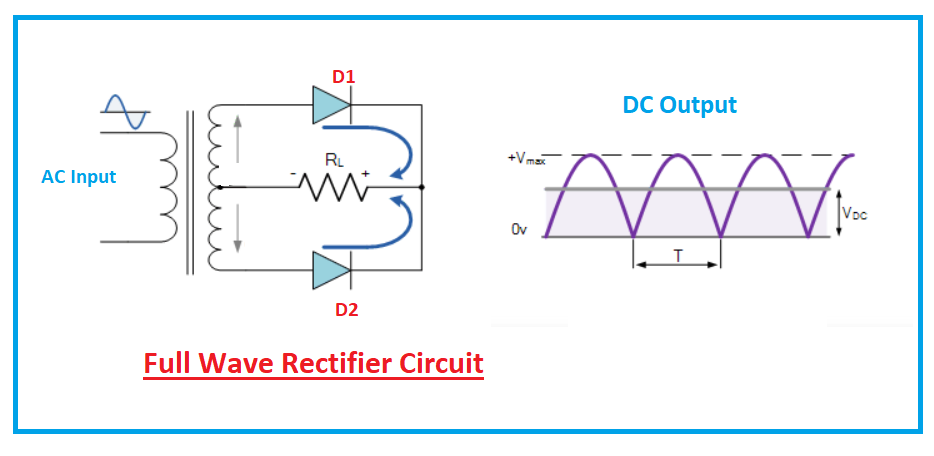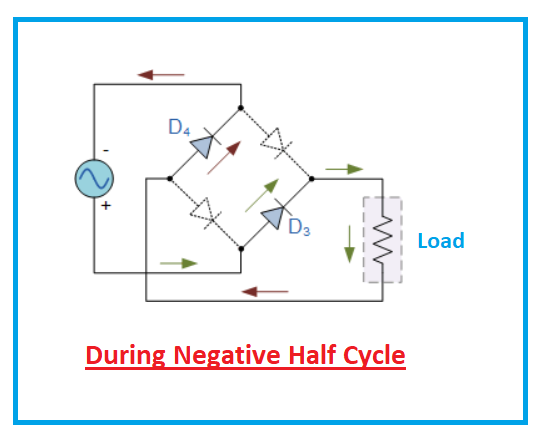A rectifier is a type of electronic component that is used to convert alternating current (AC) to direct current (DC). It does this by allowing current to flow in only one direction, which is why it is called a rectifier. There are several different types of rectifiers, including half-wave rectifiers, full-wave rectifiers, and bridge rectifiers. They are used in a wide range of applications, including power supplies, chargers, and other electronic circuits.
What is full wave rectifier?
A full-wave rectifier is a type of rectifier that converts both the positive and negative cycles of an AC waveform to DC. It is called a full-wave rectifier because it rectifies the full AC waveform, as opposed to a half-wave rectifier, which only rectifies one-half of the waveform.
A full-wave rectifier can be implemented using either a center-tap transformer or a bridge rectifier circuit. A center-tap transformer has a single secondary winding that is divided into two halves, with a tap at the center. The AC input is applied to the ends of the winding, and the rectified DC output is taken from the tap. A bridge rectifier circuit uses four diodes arranged in a bridge configuration to rectify the AC input.
Full-wave rectifiers are more efficient than half-wave rectifiers because they make use of both halves of the AC waveform. They are also less prone to producing pulsating DC output, which makes them more suitable for use in applications that require a smooth DC output.
Working of Full-wave Rectifier
The full wave rectifier circuit comes with two power diodes, each of which alternately supplies current to the load through a single load resistance (RL). The step-down transformer available in the rectifier circuit transforms high-voltage AC into low-voltage AC. The secondary winding of the transformer and the load resistor are both connected to the anode of the center-tapped diodes. The top half of the secondary winding turns positive while the second half turns negative during the positive half cycle of the alternating current.
You can also look at the Full Wave Rectification Simulation if you are curious to know about its working.

Diode D1 is forward biased (which means it will conduct) during the positive half cycle since it is connected to the top of the secondary winding, but diode D2 is reverse biased (it won’t conduct) since it is connected to the bottom of the secondary winding. This will allow the D1 to conduct as a short circuit, while D2 will not conduct as an open circuit.
Due to the top half of the secondary circuit turning negative and the bottom half of the circuit turning positive during the negative half cycle, the diodes D1 will be reverse biased and D2 will be forward biased. Hence, DC voltage is obtained for both the positive and negative half cycles in a full wave rectifier.
The formula for Full Wave Rectifier
1: Peak Inverse Voltage
The highest voltage a diode can bear in the reverse-biased direction before breaking down is known as the peak inverse voltage. A full-wave rectifier has a peak inverse voltage that is twice as high as a half-wave rectifier. PIV is 2Vmax across D1 and D2.
2: DC Output Voltage
The following formula can be used to determine the average DC output voltage.

3: RMS Value of the Current
The following formula is used to calculate the RMS value of the current.

4: Peak Factor
The peak factor can be represented by the formula given below.

5: Form Factor
The form factor can be calculated using the following formula.

The Full Wave Bridge Rectifier
The Full Wave Bridge Rectifier is another type of circuit that generates the same output waveform as the full wave rectifier circuit shown above. To create the necessary output, this kind of single-phase rectifier connects four separate rectifying diodes in a closed loop "bridge" design.

This bridge circuit comes with a key benefit that it doesn't need a specific center-tapped transformer, which reduces both its size and cost. According to the diagram below, the load is linked to one side of the diode bridge network and the single secondary winding to the other.
Working of Full Wave Bridge Rectifier
Only two of the four diodes, labeled D1 to D4, are conducting current during each half cycle because they are grouped in "series pairs." Diodes D1 and D2 conduct in series while diodes D3 and D4 are reverse biased and the current flows through the load as illustrated below during the positive half cycle of the supply.
1: During the Positive Half Cycle
Diodes D3 and D4 conduct in series during the negative half cycle of the supply, but since diodes, D1 and D2 are now reverse biased so they switch "OFF". The direction of the current flowing through the load remains the same as before.

2: During the Negative Half Cycle
The average DC voltage across the load is 0.637Vmax because the current flowing through the load is unidirectional, and the voltage that develops across the load is unidirectional as well, just like for the previous two diode full-wave rectifiers.

The output voltage is two voltage drops (2*0.7 = 1.4V) less than the input VMAX amplitude because, in practice, current flows through two diodes rather than one during each half cycle. Currently, the supply frequency is double the ripple frequency.
Applications of Full-wave Rectifier
Full-wave rectifiers are commonly used in power supplies to convert AC input voltage into a steady DC output voltage.
They can be employed to charge batteries by rectifying the AC input voltage and smoothing it using a filter circuit.
Full-wave rectifiers can be used to control the speed and torque of DC motors by rectifying the AC input voltage and controlling the DC voltage applied to the motor.
They can be used in electrolysis to produce hydrogen and oxygen gas from water by applying a DC voltage to the water.
These electrical components are used in some medical devices, such as defibrillators and electromyography machines, to convert AC input voltage into a steady DC output voltage.
Discussions
Become a Hackaday.io Member
Create an account to leave a comment. Already have an account? Log In.